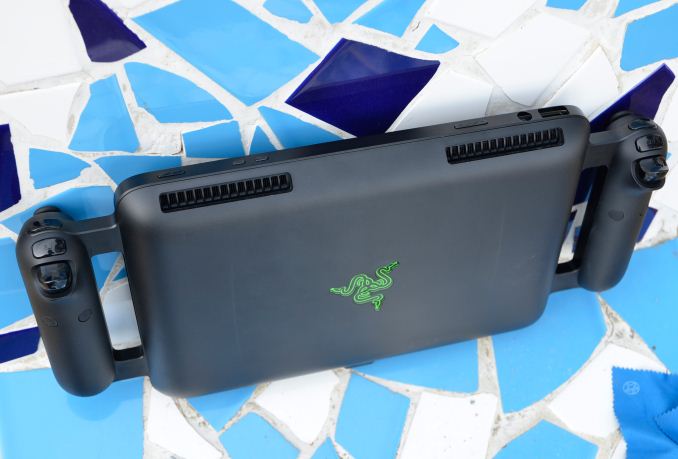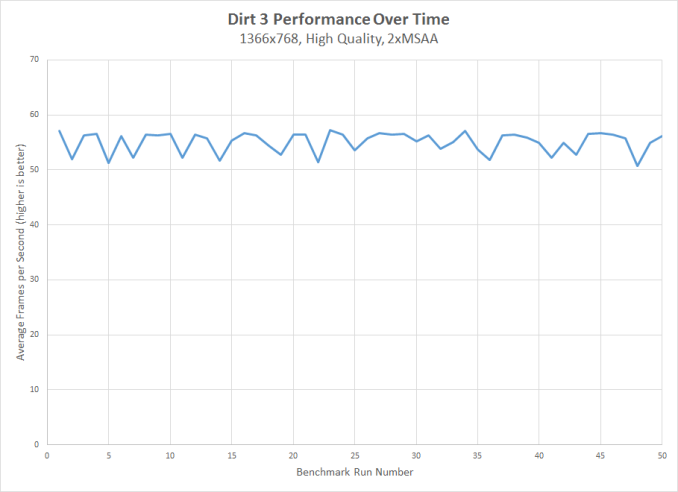The Razer Edge Review
by Vivek Gowri on March 28, 2013 11:00 AM EST- Posted in
- Tablets
- Mobile
- Razer
- Razer Edge
Thermals
The thermal story here is pretty interesting. Obviously, with a huge thermal envelope for such a small form factor, the first concern I had was for heat. Razer has a fair bit of experience shoving a lot of hardware in tight spaces, though with the Blade the problem construction was different. The Blade chassis is very thin, but has a lot of room in terms of footprint. The sheer amount of surface area top and bottom, as well as all the venting on the bottom and sides, help the Blade (especially the 2nd generation one) effectively cool itself even though there’s relatively little volume available.
The Edge, by comparison, has a tiny footprint and hence needs to be much thicker than competing tablets; it’s actually also thicker than the bottom casing of the Blade, so there’s that too. Airflow is extremely key here, since there’s very little surface area to let heat dissipate convectively. The heat pipe, too, is key, as tablets have far more orientations that need to be designed for when compared to notebooks. Orientation matters for heat pipes, as their effectiveness depends on how much working fluid can be transported from the condenser to the evaporator. Operating against gravity is always a losing proposition, and as such there’s an inverse correlation between transport capacity and operation against gravity (ie, as the angle of operation against gravity increases, the transport capacity of the heat pipes typically decrease.)
At some point in the future I’ll do a much more thorough article on how heat pipes and the cooling systems in mobile computers work, but for now this will have to suffice. The TL;DR version as pertinent to this article: if you have enough compute horsepower in a tablet to require active cooling, you’re in for a hell of a time. Tablets are much harder to cool actively than notebooks.
Which is why thermal performance was, for me at least, the major concern with the Edge prior to launch. The 0.8” thickness helped alleviate my fears somewhat, because that gets you a significant amount of volume to work with compared to something like the Surface Pro. Ivy Bridge ULV and Kepler are also pretty good as far as thermal performance goes, so I wasn’t concerned at all about how it would behave under light usage cases, particularly ones that didn’t have the GPU turning on. But when the system is stressed, what then?
To find out, I fired up my 100% system load test – Furmark 1080p and wPrime 1024M (4 threads) looping, which maxes CPU and GPU – and let it run for a sustained period of time. I saw GPU temps hit 85C with ease, while CPU got up to 95C. The GPU temperature stabilizes in the 87F region at 0.887V (the voltage at 500MHz). CPU temp stabilizes in the low 90s, which is interesting because we typically see CPU temperatures that are lower than the GPU temps. CPU power draw hovers around 14.7W when both cores are loaded. The Edge reaches thermal equilibrium before it starts throttling the GPU, which is a good sign.
I also ran my real-world gaming situation with the Dirt 3 benchmark, and like last time, ran it 50 times in a row, this time on high settings with 2xMSAA at 1366x768, my graphics setup of choice for playing the game when the Edge was plugged in. The results were pretty interesting – while average framerates stayed in the 52-56 fps range for a majority of the tests, the minimum framerate told a good bit of the story. There are three primary speeds and voltages the GPU runs at: the default 500MHz (0.887V), 570MHz (0.912V), and 405MHz (0.813V). In many of the runs in the 55-57fps range, the minimum framerate would be around 45-46fps, while some of the runs that had average fps on the low end (51-52fps), the minimum framerate would be below 40, sometimes as low as 35 fps. This happened every three or four runs, with consistency, with the GPU clocking down to the lower voltage performance state when necessary in order to maintain thermal equilibrium. At no point was there an extended period of throttling, which is why performance remained mostly constant for the roughly two and a half hours it took to go through 50 runs of the benchmark. That’s pretty impressive, considering the amount of thermal stress the GPU puts on a system of this size.












89 Comments
View All Comments
jeffkro - Friday, March 29, 2013 - link
I heard an interview with a game developer who started in PC gaming, forget which one. He said they pushed for the switch from PC to consules, tragic. Now he said their push is going to be from consules to mobile devices, even worse. These are sad days for PC gamers, and each step down to lower end hardware has cut the potential of gaming.perry1mm - Saturday, March 30, 2013 - link
I think a lot of people miss the point and just overlook the potential uses this offers for people that might travel a few weeks or even months out of the year and are on the go a lot.For work I spend a couple weeks in a hotel a year, travel to see family a week or two, and spend a few weekends away here or there, not to mention just driving around or spending time out and about sitting down someplace for an hour or two.
There is no way I'd haul around my gaming desktop, this is great for on the couch average use, docking on-the-go, and gaming when plugged while traveling.
BUT, I ended up getting the Sony Vaio Duo 11 two months ago and it does all of this stuff, has a backlit keyboard attached already, I got the extended battery on sale, and total I paid $1450 for mine with a promo + $100 credit since I got the Sony Card, plus 8500 points ($85 more dollars of Sony Rewards). So out-the-door around $1300 with the newer i7 3537u, 8GB RAM, 256GB SSD, and the HD 4000 has played 90% of the games at full resolution (1080p).
Not to mention the HDMI built in, VGA out, SD slot, 2 USB 3.0 slots, and numerous other features that make it much more handy in a laptop functionality (gaming) a lot with still being portable for touch use in tablet mode.
For the people that rip on these products as being overpriced...no. When an ARM tablet can cost $500-800 and an ultrabook $1000+, paying $200-500 more for this with the hardware you're getting, storage/SSD, and accessibility, it is NOT really that expensive.
Now if all you do is sit at home and play games for a few minutes on your phone when on-the-go, or you don't care about space and lugging around a large laptop...then maybe this isn't for you. But both the Edge and Vaio Duo for me were great fits, I just happened to be perfectly happy with the Duo as to not need the Edge.
Netscorer - Saturday, March 30, 2013 - link
Weight and battery life are killers for this product. Price is an issue but there are people willing to pay for the mobility and they would not mind paying extra for exclusivity too. But once you consider that you always (ALWAYS!) need to brace this tablet against something (be it a lap on a train or table at the coffee shop) and that even then you can get at most 2 hours on a freshly charged batteries, the appeal of this hybrid goes way down and frankly, you can do the same on a laptop with a good trackpad, costing much less and having more versatility in other functions. By the way, I was surprised that Vivek never mentioned how absence of the physical keyboard affected using this device. Microsoft did a piss poor job with the virtual keyboard that blocks 2/3 of the screen every time you bring it up and when something like this happens as you prepare to game, it would be a major nuisance.MobiusStrip - Monday, April 1, 2013 - link
Look at that idiotic glossy screen.Death666Angel - Monday, April 1, 2013 - link
It's definitely an interesting product. I don't need a portable gaming machine, so this isn't for me. But even if it were: no display output and the display resolution kill it for me. You may justify the resolution, but it is still not acceptable for me. I'd rather have smaller pixels so that non-native resolutions look better as well. This is a compromise I'm not willing to put up with (and yes, I know that higher resolution would also mean more power draw from the display at same brightness). Also, 11.6" would have been a better display size in my opinion, could have upped the battery package or reduced the thickness. And I personally still don't play FPS games with a gamepad (or many other types for that matter) so for many games I'd need the dock and a keyboard/mouse. All in all, I think I'm better off with sticking with my Ativ Pro for the few games I want to play when I'm on holidays. :DAs for the review: Well done. But I'd really like a comment on whether or not this tablet supports Optimus and the corresponding battery life. :)
IceStorm - Tuesday, April 2, 2013 - link
As an Edge Pro owner, I agree with what has been written in the review. I've been busy installing and playing games since it arrived yesterday. It is fun.I have tried the Surface Pro. The lower resolution of the Edge is not an issue. If anything, it makes it easier to select things when at the traditional desktop. The screen is quite nice, and I have a retina iPad and a Kindle Fire HD for comparison.
This is an early adopter product. It is not for everyone. Just like the first Blade, if you balk at the price it isn't for you. The Razer store sold out of the initial production run of the 256GB Edge Pro in less than five hours. There is a market for it.
seapeople - Sunday, April 7, 2013 - link
I can picture the scene now outside the Razer store. A bunch of happy gamers walking out to their Corolla's, stumbling over the curb as they are locked into an intense game of Half Life, while dozens of well dressed men in suits shake there head and sneer as they lament how much money these gamers are wasting on this platform. The men in suits then jump into their Ferrari 328 GTS's and cruise off into the sunset, waiting in tempered melancholy for the day when they, too, will have the means to afford a handheld gaming unit that will bring joy to their lives.0 adrian 0 - Wednesday, April 3, 2013 - link
.MajinBlayze - Tuesday, December 3, 2013 - link
In your review regarding the downgrade from the pro version:"You lose the 1080p display and Wacom digitizer"
according to the support page here: http://www.razersupport.com/gaming-systems/razer-e... "The Razer Edge is not Wacom or pressure sensitive compatible"